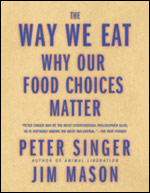One summer evening when I lived in Crown Heights, Brooklyn, I was snipping basil from the potted herb garden that I kept on the stoop in front of my brownstone apartment. Kids were playing on the sidewalk, their high-spirited shouts echoing through the dense, humid air. I absently popped a basil leaf in my mouth, savoring its flavor.

You ate what?
Photo: iStockphoto
One kid took note. “Oooh!” he shouted. “He ate a plant!” Suddenly, seven or eight ten-year-olds were pointing and gaping at me. I had done something exotic, strange, suspect even: I had eaten plant matter.
For me, the story illustrates how far we in the so-called advanced economies have traveled from our agricultural roots. In 1930, 20 percent of Americans owed their livelihoods to farming. Today, fewer than 2 percent do. Nearly 40 percent of food is consumed outside the home. In essence, we’ve entered a post-agricultural age. Knowledge about food production, which used to come from direct experience in the field or in the kitchen, now comes from food-industry marketing execs and government directives.
Where does our food come from?
For most Americans, the answer is simple enough: supermarkets and restaurants. In a nation in which almost nobody farms and few regularly cook, that’s a fair response. Of course, such skim-level reasoning hides vast social, ecological, and economic chains that ultimately tether us to the earth. People can blithely devour, say, Chicken McNuggets dipped in ketchup, without ever thinking about the lot of factory-farmed chickens, working conditions in slaughterhouses or on farms, or the chemicals used to fertilize fields and kill weeds and pests.
Happily, a cottage industry has emerged within the publishing world to right the matter. Eric Schlosser, in his groundbreaking Fast Food Nation, brought an investigative reporter’s zeal to tracing the holy trinity of American eating — burger, fries, and a Coke — back to the far-flung fields, factories, corporate marketing meetings, and laboratories from which they hail. Fast Food Nation, a best seller soon to hit the big screen as a fictionalized film, reminded many Americans that what’s on their plate has a history worth thinking about. And it taught New York book editors that food politics can sell.

The Omnivore’s Dilemma: A
Natural History of Four Meals,
by Michael Pollan.
This year has been a watershed in the food-politics publishing boom. No fewer than four books released in 2006 tread down the path broken by Schlosser. The best-known, Michael Pollan‘s best-seller Omnivore’s Dilemma, is probably also the best. The author provides an exhaustive “natural history of four meals.” Broadening Schlosser’s mandate, Pollan trains a hungry eye not just on industrially produced fare, but also on the alternatives that have arisen over the past few decades. He subjects the various U.S. food chains not just to a cold reporter’s eye, but also to his gourmand’s palate. He reminds us that the industrialization of the food supply has caused more than just environmental and bodily damage. It’s also ruined many people’s ability to take real pleasure in food.
Pollan’s analysis implies something hopeful, though: that by reclaiming the pleasures of the table, we can reverse much of the environmental and social wreckage we create in feeding ourselves. Hedonism, he implies, always suspect in the vague but persistent Puritanical strain that runs through American culture, may be socially useful after all.

The Way We Eat: Why Our
Food Choices Matter,
by Peter Singer and Jim Mason.
For Peter Singer and Jim Mason, the veteran animal-rights polemicists, the pleasure principle doesn’t matter much. They’ve come out with The Way We Eat: Why Our Food Choices Matter, a book similar in ambition and scope to Omnivore’s Dilemma. But if Pollan returns again and again to aesthetics — parsing, say, the subtle differences in flavor between a grain-fed Whole Foods organic chicken and a pasture-raised one slaughtered on the farm — Singer and Mason focus solely on ethics. What are the costs, and who (or what) pays them, when I choose between, say, a meal based on meat procured at Wal-Mart or made from tofu bought at Whole Foods?
As a framing device, the authors devote major sections to three families: one that eats the “standard American diet” of industrially produced fare; another made up of “conscientious omnivores” who eat “humanely produced” meat and mostly organic vegetables; and (clearly closest to the authors’ hearts) a family of strict vegans. Singer and Mason tag along with each family on grocery-shopping ventures and hang out in the kitchen to cook and eat. Then they trace the major food items to their origins, exhaustingly documenting the production conditions.
While the wealth of information on display here is impressive — anyone who takes the ethics of eating seriously will want to own this book — the authors’ lack of regard for aesthetics and pleasure occasionally leads them into odd territory. At one point, they applaud an effort to conjure up “animal-free meat,” which they describe as a “vast lump of meat, hundreds of feet across, growing in a culture fed on algae.” They fret that with current technology, “producing muscle tissue in a laboratory equates to $5 million per kilogram,” but hold out hope that one day such a process will be economical enough to “supply the entire world with meat.” They award the project their highest accolade: “we can see no ethical objection to it.”
Yet the moral calculus here seems shaky. Do we really want food corporations leaching cells from animals and creating “food” in vast petri dishes? To remedy the ravages of industrial food production, Singer and Mason prescribe more industrial food production. The pasture-based, agrarian approach to meat championed by Pollan, predicated on moderation, seems to me more morally robust — and certainly more palatable.

Organic, Inc.: Natural Foods and
How They Grew,
by Samuel Fromartz.
Another book released this year, Samuel Fromartz’s Organic, Inc.: Natural Foods and How They Grew, focuses on the rapidly growing organic-food industry. Unfortunately for Fromartz, Omnivore’s Dilemma, which came out a couple of months earlier, covers much of the same ground. But Organic, Inc. remains worth a read. A veteran business reporter, Fromartz knows how to lay out an industry’s history in compelling fashion. His chapter on California’s organic baby-lettuce business — responsible for those bags of pre-washed, flavorless salad greens now found everywhere from Whole Foods to Wal-Mart — should be required reading for anyone interested in the commodification of organic.
Fromartz details how the baby lettuce craze started when Berkeley restaurateur Alice Waters ate a peppery mesclun salad in Nice in the early ’80s. Her will to recreate that experience in Northern California helped catalyze what’s now a $2.5 billion industry. Fromartz describes how the mass production of baby lettuce drove prices down, making the product widely accessible but compromising its flavor and driving many small producers out of business. These same processes, though, provided opportunities for new growers who sell direct to consumers in local markets, competing with the California giants based not on price but on flavor. Thus Waters’ vision of peppery Nice-style greens lives on in niches — for those who can afford it.
In Organic, Inc.‘s most important chapter, Fromartz profiles Pennsylvania farmers Jim and Moie Crawford, one of the great success stories of the U.S. farmers’ market movement. The Crawfords were among the back-to-the-landers who pioneered the practice of selling directly to consumers. Fromartz is excellent at teasing out the incredible amount of drive, tenacity, and innovation it takes to create a successful local-oriented farm business — and conveying how even the best-established operations rest on shaky economic ground. After 35 years of farming and now approaching 60, the Crawfords are still waking up at 3:30 a.m. to make the two-and-a-half hour trek to their Washington, D.C., farmers’ market stand. And they still have yet to build a comfortable retirement fund. Such are the sacrifices, Fromartz implies, needed to create a robust local food economy in a market dominated by giant retailers and megafarms.

Chew on This: Everything You
Don’t Want to Know About Fast
Food,
by Eric Schlosser and
Charles Wilson.
Of all the food-politics books released in 2006, the one with the most impact may end up being the one that seems the least significant. Eric Schlosser himself, teaming up with journalist Charles Wilson, has come out with Chew on This: Everything You Don’t Want to Know About Fast Food. Like fast-food marketing execs, Schlosser and Wilson know that the easiest way to affect U.S. eating habits is to focus on the young and impressionable. The fast-food industry has pursued this goal by directing hundreds of millions of marketing dollars toward the young. Schlosser and Wilson have responded by repackaging Fast Food Nation to appeal to young readers. Their goal: to make kids who have been drawn in by the fast-food industry’s well-engineered aromas “turn and walk out the door” without ordering.
Chew on This is a tour de force of agitprop, backed by 30 pages of footnotes and the reportorial integrity that made Fast Food Nation impervious to the industry’s attempts to discredit it. I have no idea how kids will respond, but I found the book’s straight-talk style and simple, jokey prose irresistible. Under assault by Schlosser and other sources, the industry has strained over the past few years to burnish its image. Parts of McDonald’s website these days read as though they were written by the Sierra Club. Chew on This shreds this empty rhetoric like a factory cutter preparing iceberg lettuce for its place on a million Big Macs. I hope the book finds a wide audience among kids — and their parents and teachers too.
Despite the publishing blitz, it remains unlikely that many Americans know or care much about where their food comes from. But these books may represent stirrings of a new, or at least long-repressed, hunger — a desire to reconnect to the sources of our subsistence. The more we know about how our food is produced, the less likely we’ll be to accept the slop cooked up by industry — or the environmental and social damage caused in the process.


